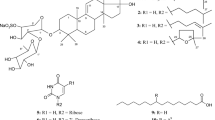Abstract
Aplydactylonins A-C (1–3), three new sesquiterpenes, were isolated from the Vietnamese sea hare Aplysia dactylomela. Their structures and absolute configurations were elucidated based on spectroscopic analysis, X-ray crystallography, and density functional theory (DFT) calculations of NMR and ECD data. Compound 2 exhibited cytotoxicity against HepG2, DU145 and A549 cells with respective IC50 values of 4.08 ± 0.63, 38.64 ± 1.04 and 12.33 ± 0.95 µM. In addition, HepG2 cells treated with 5 μM compound 2 for 48 h showed a significant increase in early apoptotic cells (P < 0.05) and increased caspase 3 activity (P < 0.01). Moreover, compound 2 induced sub-G1 phase arrest in HepG2 cells.









Similar content being viewed by others
References
Pereira R, Andrade P, Valentão P (2016) Chemical diversity and biological properties of secondary metabolites from Sea Hares of Aplysia Genus. Mar Drugs 14:39
Palaniveloo K, Rizman-Idid M, Nagappan T, Abdul Razak S (2020) Halogenated metabolites from the diet of Aplysia dactylomela rang. Molecules 25:8152
Huong PTM, Phong NV, Thao NP, Binh PT, Thao DT, Thanh NV, Cuong NX, Nam NH, Thung DC, Minh CV (2020) Dendrodoristerol, a cytotoxic C20 steroid from the Vietnamese nudibranch mollusk Dendrodoris fumata. J Asian Nat Prod Res 22:193–200
Thanh NV, Thao NP, Phong NV, Cuong NX, Nam NH, Minh CV (2020) A new [7.7]paracyclophane from Vietnamese marine snail Planaxis sulcatus (Born, 1780). Nat Prod Res 34:261–268
Lodewyk MW, Siebert MR, Tantillo DJ (2012) Computational prediction of 1H and 13C chemical shifts: a useful tool for natural product, mechanistic, and synthetic organic chemistry. Chem Rev 112:1839–1862
De Vita S, Terracciano S, Bruno I, Chini MG (2020) From natural compounds to bioactive molecules through NMR and in silico methodologies. Eur J Org Chem 2020:6297–6317
Kim CS, Oh J, Lee TH (2020) Structure elucidation of small organic molecules by contemporary computational chemistry methods. Arch Pharm Res 43:1114–1127
Nazarski RB (2021) Summary of DFT calculations coupled with current statistical and/or artificial neural network (ANN) methods to assist experimental NMR data in identifying diastereomeric structures. Tetrahedron Lett 71:152548
Lauro G, Bifulco G (2020) Elucidating the relative and absolute configuration of organic compounds by quantum mechanical approaches. Eur J Org Chem 2020:3929–3941
Sarotti AM, Pellegrinet SC (2009) A multi-standard approach for GIAO 13C NMR calculations. J Org Chem 74:7254–7260
Sarotti AM, Pellegrinet SC (2012) Application of the multi-standard methodology for calculating 1H NMR chemical shifts. J Org Chem 77:6059–6065
Wibowo M, Prachyawarakorn V, Aree T, Mahidol C, Ruchirawat S, Kittakoop P (2016) Cytotoxic sesquiterpenes from the endophytic fungus Pseudolagarobasidium acaciicola. Phytochemistry 122:126–138
Flack HD, Bernardinelli G (2008) The use of X-ray crystallography to determine absolute configuration. Chirality 20:681–690
Fukuzawa A, Shea CM, Masamune T, Furusaki A, Katayama C, Matsumoto T (1981) Structure of spironippol, a new sesquiterpene, from the red alga laurencia nipponica yamada. Tetrahedron Lett 22:4087–4088
Ji N-Y, Li X-M, Li K, Gloer JB, Wang B-G (2008) Halogenated sesquiterpenes and non-halogenated linear C15-acetogenins from the marine red alga Laurencia composita and their chemotaxonomic significance. Biochem Syst Ecol 36:938–941
Mosmann T (1983) Rapid colorimetric assay for cellular growth and survival: application to proliferation and cytotoxicity assays. J Immunol Methods 65:55–63
Ouyang L, Shi Z, Zhao S, Wang FT, Zhou TT, Liu B, Bao JK (2012) Programmed cell death pathways in cancer: a review of apoptosis, autophagy and programmed necrosis. Cell Prolif 45:487–498
Dickson MA, Schwartz GK (2009) Development of cell-cycle inhibitors for cancer therapy. Curr Oncol 16:36–43
Riccardi C, Nicoletti I (2006) Analysis of apoptosis by propidium iodide staining and flow cytometry. Nat Protoc 1:1458–1461
Trang DT, Hoang TKV, Nguyen TTM, Van Cuong P, Dang NH, Dang HD, Nguyen Quang T, Dat NT (2020) Essential oils of lemongrass (Cymbopogon citratus Stapf) induces apoptosis and cell cycle arrest in A549 lung cancer cells. Biomed Res Int 2020:5924856
Phan MG, Do TT, Nguyen TN, Do TVH, Dong NP, Vu MT (2021) Chemical constituents of Eupatorium japonicum and anti-inflammatory, cytotoxic, and apoptotic activities of Eupatoriopicrin on cancer stem cells. Evid Based Complement Altern Med 2021:6610347
Acknowledgements
This work was supported by the Vietnam Academy of Science and Technology (Grant number: KHCBBI.02/19-21). We thank Dr. Dang Vu Luong (Institute of Chemistry, VAST, Hanoi, Vietnam) for NMR spectra measurement.
Author information
Authors and Affiliations
Corresponding author
Additional information
Publisher's Note
Springer Nature remains neutral with regard to jurisdictional claims in published maps and institutional affiliations.
Supplementary Information
Below is the link to the electronic supplementary material.
Rights and permissions
About this article
Cite this article
Huong, P.T.M., Phong, N.V., Huong, N.T. et al. Aplydactylonins A-C, three new sesquiterpenes from the Vietnamese sea hare Aplysia dactylomela and their cytotoxicity. J Nat Med 76, 210–219 (2022). https://doi.org/10.1007/s11418-021-01582-2
Received:
Accepted:
Published:
Issue Date:
DOI: https://doi.org/10.1007/s11418-021-01582-2



